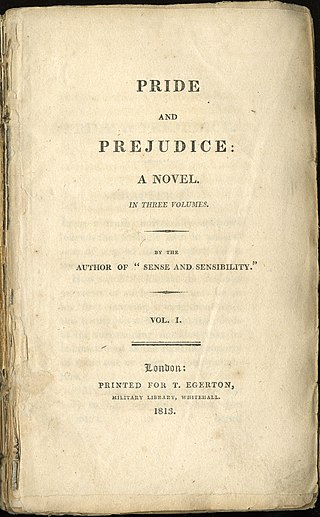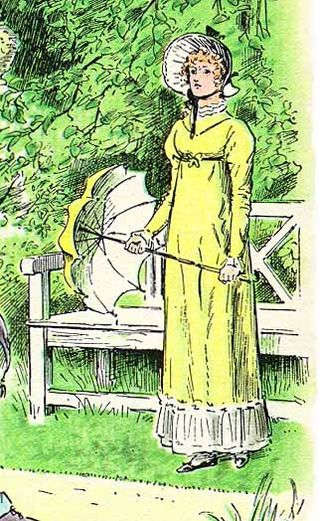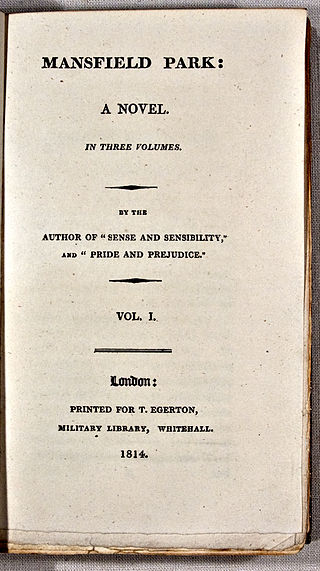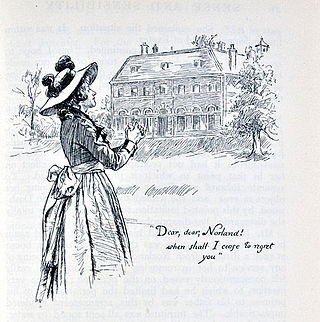The Beautifull Cassandra[ sic ] is a short novel from Jane Austen's juvenilia. It is a parody of the melodramatic, sentimental and picaresque novels of the time, [1] and tells the story of a young woman who sets off into the world to make her fortune.
Austen creates the characters and pastiche without authorial embellishment, in a brief work compressing twelve chapters into three pages. [2] She sets the tone for this style in a dedication – "to Miss Austen" – that parodies flowery literary praise: "Madam, You are a Phoenix [...] Your person is lovely [...] your conversation is rational and your appearance singular". [3]
Austen then progresses to a story in which the heroine is "lovely & amiable & chancing to fall in love with an elegant Bonnet [...] walked [out] [...] to make her fortune". [4] All three of the listed characteristics, and the result, have precedents in the literature of Austen's period, and each would evoke a series of associations in the mind of the reader; but Austen restructures the associations by the fashion in which she gives each of these particular items the same effect on the outcome. This readjustment creates a new perspective of accepted motifs and allows Austen to place herself outside of the framework of a single genre, raising fairy tale, [5] or even nursery rhyme expectations, [6] only to disappoint them. Such flexibility on the part of the author results in richer characterizations: Cassandra is constructed in fewer than thirty sentences and Austen relies on the audience's appreciation of the references she makes to issues of lineage, adventure, expectations of beauty and typical relationships.
This small character has her own being, both within the text and on her own – one that reflects much of the life that would be brought to Austen's later characters: her mischievousness, and even delinquency, [7] are especially typical of Austen's adolescent work, with extreme behavior and self-indulgence providing the prevailing tone. Thus, for example at a pastry-shop, Cassandra “devoured six ices, refused to pay for them, knocked down the Pastry-Cook and walked away”, concluding to herself at the end of all her similarly delinquent adventures that“ 'This is a day well spent“. [8]

Jane Austen was an English novelist known primarily for her six novels, which implicitly interpret, critique, and comment upon the British landed gentry at the end of the 18th century. Austen's plots often explore the dependence of women on marriage for the pursuit of favourable social standing and economic security. Her works are an implicit critique of the novels of sensibility of the second half of the 18th century and are part of the transition to 19th-century literary realism. Her deft use of social commentary, realism and biting irony have earned her acclaim among critics and scholars.

Pride and Prejudice is the second novel by English author Jane Austen, published in 1813. A novel of manners, it follows the character development of Elizabeth Bennet, the protagonist of the book, who learns about the repercussions of hasty judgments and comes to appreciate the difference between superficial goodness and actual goodness.

Sense and Sensibility is the first novel by the English author Jane Austen, published in 1811. It was published anonymously; By A Lady appears on the title page where the author's name might have been. It tells the story of the Dashwood sisters, Elinor and Marianne as they come of age. They have an older half-brother, John, and a younger sister, Margaret.

Northanger Abbey is a coming-of-age novel and a satire of Gothic novels written by the English author Jane Austen. Although the title page is dated 1818 and was published posthumously in 1817 with Persuasion, Northanger Abbey was completed in 1803, making it the first of Austen's novels to be completed in full. From a fondness of Gothic novels and an active imagination distorting her worldview, the story follows Catherine Morland, the naïve young protagonist, as she develops to better understand herself and the world around her.

Emma is a novel written by English author Jane Austen. It is set in the fictional country village of Highbury and the surrounding estates of Hartfield, Randalls and Donwell Abbey, and involves the relationships among people from a small number of families. The novel was first published in December 1815, although the title page is dated 1816. As in her other novels, Austen explores the concerns and difficulties of genteel women living in Georgian–Regency England. Emma is a comedy of manners.

Persuasion is the last novel completed by the English author Jane Austen. It was published on 20 December 1817, along with Northanger Abbey, six months after her death, although the title page is dated 1818.
Sanditon (1817) is an unfinished novel by the English writer Jane Austen. In January 1817, Austen began work on a new novel she called The Brothers, later titled Sanditon, and completed eleven chapters before stopping work in mid-March 1817, probably because of illness. R.W. Chapman first published a full transcription of the novel in 1925 under the name Fragment of a Novel.

Lady Susan is an epistolary novella by Jane Austen, possibly written in 1794 but not published until 1871. This early complete work, which the author never submitted for publication, describes the schemes of the title character.

Elizabeth Bennet is the protagonist in the 1813 novel Pride and Prejudice by Jane Austen. She is often referred to as Eliza or Lizzy by her friends and family. Elizabeth is the second child in a family of five daughters. Though the circumstances of the time and environment push her to seek a marriage of convenience for economic security, Elizabeth wishes to marry for love.

Becoming Jane is a 2007 biographical romantic drama film directed by Julian Jarrold. It depicts the early life of the British author Jane Austen and her lasting love for Thomas Langlois Lefroy. American actress Anne Hathaway stars as the title character, while her romantic interest is played by Scottish actor James McAvoy. Also appearing in the film are Julie Walters, James Cromwell and Maggie Smith. This was Ian Richardson's final film performance before his death in the same year as the film's release. The film was produced in cooperation with several companies, including Ecosse Films and Blueprint Pictures. It also received funding from the Irish Film Board and the UK Film Council Premiere Fund.
Free indirect speech is the literary technique of writing a character's first-person thoughts in the voice of the third-person narrator. It is a style using aspects of third-person narration conjoined with the essence of first-person direct speech. The technique is also referred to as free indirect discourse, free indirect style, or, in French, discours indirect libre.

Mansfield Park is the third published novel by the English author Jane Austen, first published in 1814 by Thomas Egerton. A second edition was published in 1816 by John Murray, still within Austen's lifetime. The novel did not receive any public reviews until 1821.
The sentimental novel or the novel of sensibility is an 18th- and 19th-century literary genre which presents and celebrates the concepts of sentiment, sentimentalism, and sensibility. Sentimentalism, which is to be distinguished from sensibility, was a fashion in both poetry and prose fiction beginning in the eighteenth century in reaction to the rationalism of the Augustan Age.

The Watsons is an abandoned novel by Jane Austen, probably begun about 1803. There have been a number of arguments advanced as to why she did not complete it, and other authors have since attempted the task. A continuation by Austen's niece was published in 1850. The manuscript fragment itself was published in 1871. Further completions and adaptations of the story have continued to the present day.

Catherine Anne Hubback was an English novelist, and the eighth child and fourth daughter of Sir Francis Austen (1774–1865), and niece of English novelist Jane Austen.

Jane Austen lived her entire life as part of a family located socially and economically on the lower fringes of the English gentry. The Rev. George Austen and Cassandra Leigh, Jane Austen's parents, lived in Steventon, Hampshire, where Rev. Austen was the rector of the Anglican parish from 1765 until 1801. Jane Austen's immediate family was large and close-knit. She had six brothers—James, George, Charles, Francis, Henry, and Edward—and a beloved older sister, Cassandra. Austen's brother Edward was adopted by Thomas and Elizabeth Knight and eventually inherited their estates at Godmersham, Kent, and Chawton, Hampshire. In 1801, Rev. Austen retired from the ministry and moved his family to Bath, Somerset. He died in 1805 and for the next four years, Jane, Cassandra, and their mother lived first in rented quarters and then in Southampton where they shared a house with Frank Austen's family. During these unsettled years, they spent much time visiting various branches of the family. In 1809, Jane, Cassandra, and their mother moved permanently into a large "cottage" in Chawton village that was part of Edward's nearby estate. Austen lived at Chawton until she moved to Winchester for medical treatment shortly before her death in 1817.

Marianne Dashwood is a fictional character in Jane Austen's 1811 novel Sense and Sensibility. The 16-year-old second daughter of Mr. and Mrs. Henry Dashwood, she mostly embodies the "sensibility" of the title, as opposed to her elder sister Elinor's "sense".

A Memoir of Jane Austen is a biography of the novelist Jane Austen (1775–1817) published in 1869 by her nephew James Edward Austen-Leigh. A second edition was published in 1871 which included previously unpublished Jane Austen writings. A family project, the biography was written by James Edward Austen-Leigh but owed much to the recollections of Jane Austen's many relatives. However, it was the decisions of her sister, Cassandra Austen, to destroy many of Jane's letters after her death that shaped the material available for the biography.
Jane Austen's (1775–1817) distinctive literary style relies on a combination of parody, burlesque, irony, free indirect speech and a degree of realism. She uses parody and burlesque for comic effect and to critique the portrayal of women in 18th-century sentimental and Gothic novels. Austen extends her critique by highlighting social hypocrisy through irony; she often creates an ironic tone through free indirect speech in which the thoughts and words of the characters mix with the voice of the narrator. The degree to which critics believe Austen's characters have psychological depth informs their views regarding her realism. While some scholars argue that Austen falls into a tradition of realism because of her finely executed portrayal of individual characters and her emphasis on "the everyday", others contend that her characters lack a depth of feeling compared with earlier works, and that this, combined with Austen's polemical tone, places her outside the realist tradition.

Georgian society in Jane Austen's novels is the ever-present background of her work, the world in which all her characters are set. Entirely situated during the reign of George III, the novels of Austen describe their characters' everyday lives, joys, sorrows, and loves, providing insight into the period.